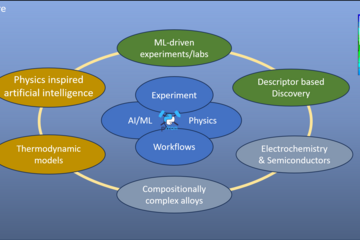All genres
11441.
Thesis - Diploma
Cementite in Ferrite from First-Principles: Influence of Substitutional Impurities on Thermodynamic Stability. Diploma, RWTH Aachen, Aachen, Germany (2011)
11442.
Thesis - Diploma
Untersuchung der Grenzflächen von Nickel-Basis Legierungen mittels Atomsondentomograpie. Diploma, Heinrich-Heine Universität Düsseldorf, Düsseldorf [Germany] (2010)
11443.
Thesis - Diploma
A Spectral Method Using Fast Fourier Transform to Solve Elastoviscoplastic Mechanical Boundary Value Problems. Diploma, TUM, München, Germany (2010)
11444.
Thesis - Diploma
Schädigungsmechanismen und Entwicklung der Mikrostruktur eines Al-legierten TRIP-Stahls im Laufe der Verformung. Diploma, RWTH Aachen, Aachen, Germany (2008)
11445.
Thesis - Diploma
Ab initio Berechnung von Phononenspektren in Systemen mit reduzierter Symmetrie. Diploma, Technische Fachhochschule Berlin, Berlin, Germany (2008)
11446.
Thesis - Diploma
Ab initio Studie der Energetik und Dynamik von Wasserstoff in Metallen. Diploma, Technische Fachhochschule Berlin, Berlin, Germany (2008)
11447.
Thesis - Diploma
Developing a general purpose database application for multiphysics. Diploma, Fachhochschule Aachen, Standort Jülich, Jülich, Germany (2008)
11448.
Thesis - Diploma
Thermische Ermüdung eines CrN. Diploma, Montanuniversität Leoben, Leoben (2008)
11449.
Thesis - Diploma
Entwicklung und Charakterisierung hochfester Beta-Titan-Legierungen für Fahrzeugkomponenten. Diploma, Gerhard-Mercator Universität GH, Duisburg (2004)
11450.
Thesis - Diploma
Untersuchung der Abhängigkeit des Ölaustrags von der Oberflächenfeinstruktur beim Auswalzen gedoppelter Aluminiumfolien. Diploma, HS Niederrhein, Krefeld, Germany (2003)
11451.
Thesis - Diploma
Deformation of Semi-Brittle Intermetallic Material under Superimposed Hydrostatic Pressure. Diploma, Ecole Centrale de Nantes, Nantes, France (2002)
11452.
Thesis - Master
Synthesis and Characterization of Reactive Magnetron Sputtered Fe1−xO Thin Films. Master, HHU Düsseldorf (2023)
11453.
Thesis - Master
Algorithms for optimal chemical ordering. Master, University of Passau (2021)
11454.
Thesis - Master
Scanning electron microscopy study of the microscale degradation mechanisms in polymer electrolyte fuel cells. Master, Heinrich-Heine-Universität Düsseldorf (2021)
11455.
Thesis - Master
Solidification and precipitated structure of Al20CoxCr20Fe35Ni20-xTi5 (x = 0, 10, 20) compositionally complex alloys. Master, Heinrich-Heine-Universität Düsseldorf (2021)
11456.
Thesis - Master
Concentration-dependent finite temperature effects in metallic alloys. Master, Ruhr-Universität Bochum (2021)
11457.
Thesis - Master
An optimized method to determine initial parameters of advanced yield surfaces for sheet metal form-ing applications. Master, Ruhr-Universität Bochum (2021)
11458.
Thesis - Master
Electron microscopy degradation studies of ruthenium-platinum core-shell nanoparticles for polymer electrolyte membrane fuel cells. Master, Universitat Autònoma de Barcelona, Spain (2021)
11459.
Thesis - Master
Thermodynamics of binary alloys at atomistic scale. Master, Ruhr-Universität Bochum (2020)
11460.
Thesis - Master
Hydrogen Associated Decohesion and Localized Plasticity in a Dual-phase Lightweight Steel. Master, RWTH Aachen University (2020)


